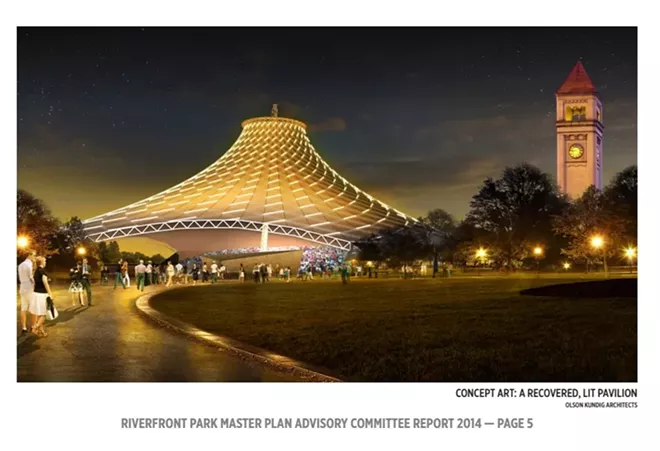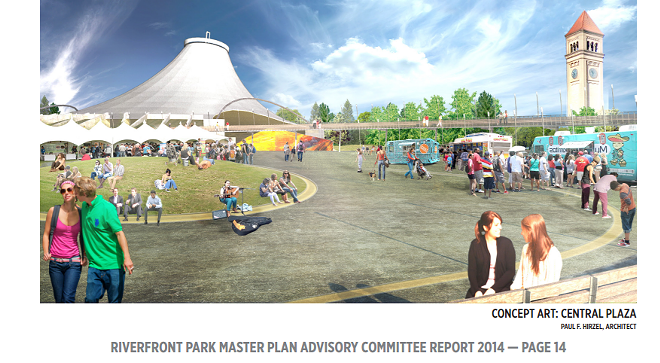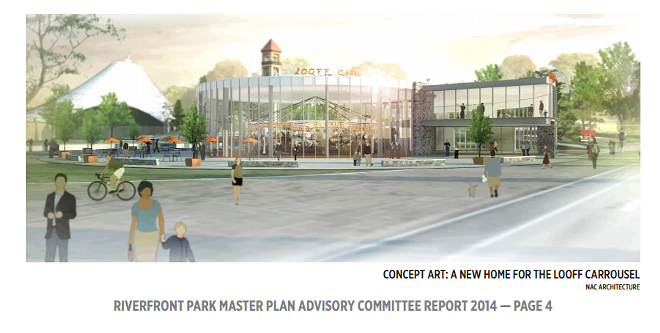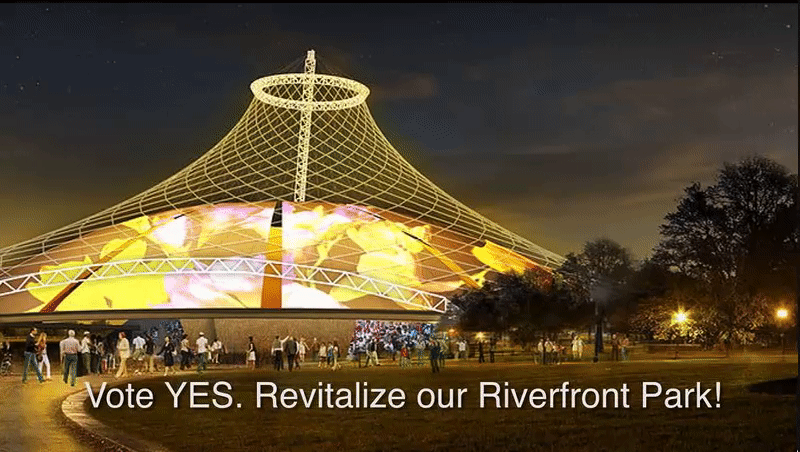
Call it a promise, call it a proposal, call it a plan, or call it a possibility.
But before the Riverfront Park bond was passed in 2014 — and in the months after — public officials repeatedly articulated a plan for the park bond that including covering the U.S. Pavilion, either by stretching material on the outside of the skeleton webbing or building a dome-like structure inside.
Time and time again, the message was clear: One way or another, the space inside the pavilion would be covered.
Yet in a
Instead, the proposed design featured a series of platforms and walkways that would allow visitors to ascend the structure and take in the views of the park.
It was a decision that left Randy Cameron, Park Board president when the 2014 bond was passed, fuming. In a Facebook post this week, Cameron wrote that the pavilion was the "centerpiece" of the Riverfront Park master plan placed on the ballot, and getting rid of the covering was "OUTRAGEOUS!"
"The Pavilion ALWAYS was to have lights,
At a lengthy meeting yesterday, the Park Board opted to table a vote on ditching plans to fully cover the pavilion until next month, asking the outside design-build team to gather more information.
In the meantime, the debate hinges on key questions: First, simply, what is the best design for the pavilion that can be built with the money available? And second, how much can the plan that the taxpayers voted on change without voters feeling cheated?
Time and time again, the message was clear: One way or another, the space inside the pavilion would be covered.
Other than the Clock Tower, the pavilion is arguably the landmark most iconically associated with Spokane. Any major change was bound to be controversial. But the bond language itself was vague: It simply described the "renovation, improvement and modernization of the aging infrastructure of Riverfront Park, including the ... U.S. Pavilion."
Yet the discussion leading up to the bond measure repeatedly cited one type of pavilion covering or another.When the volunteers on the Riverfront Park Master Plan advisory committee — helmed by McGregor — developed a sweeping proposal to renovate Riverfront Park, the pavilion became a centerpiece of the discussion.
"The old United States Pavilion is our Space Needle — the icon of Spokane that appears as shorthand for Spokane," the committee's final report says. "And there is genuine symbolism to it: It’s our centerpiece, the place where we righted the wrongs of the past and restored our River."
Ultimately, the committee ranked the five different priorities for the overhaul of the park, and covering the pavilion was ranked second, behind only building a north-south promenade.
"The committee favors re-covering the Pavilion tent structure and to incorporate new lighting and/or projected imagery to create a focal point and add to the Park’s 'Wow!' factor," the report says.
In fact, every concept art rendering featuring the pavilion in the 21-page document shows the structure covered in some fashion:
The report dives into the proposal in greater detail.
If you look at the Pavilion, it’s obvious that something’s missing. The roof fell off in the 1980s and we never replaced it. Our committee wants to see that roof replaced for a variety of reasons, not the least of which being the symbolic importance of restoring it to full glory.
It also would create shade for summer events, and heat is a problem. And with 21st-century lighting, we feel it could become a potent icon and attraction all its own. The good news is there are modern materials that are rated to last many decades — as you can see at the Denver and Riyadh airports. Our committee favors something a little more translucent, to let more light in, than the canvas we had in 1974.
While the committee wants to re-cover the Pavilion, we did not totally settle on what that would look like; one consultant wowed us with a vision of an inner dome inside the wire skeleton of the Pavilion. It could be moved around to protect the interior from rain, and it would make a cool canvas to project films or images onto. It was an amazing vision, so the idea of re-covering it does open the Park up to a lot of exciting ideas.
McGregor says that the vote on the Riverfront Park Master Plan Advisory Committee to make covering the pavilion part of the master plan wasn't unanimous, but a majority supported it, including him. He liked how it called back to Expo '74.
"For me, it felt like a way to restore the once and future park," McGregor says today. "But I’ve [now] seen a lot of other ways to do it. It also needs to be a park for the future. Expo is a neat thing, but it doesn’t need to be a driving force for every decision."
But back in 2014, the proposal was embedded right there in the master plan that the city council and Park Board approved: "Re-covered and re-lit Pavilion," the plan says, elaborating that the plan would strive to "re-sheath the Pavilion in a more [durable] material... as well as allowing for video projections both interior and exterior to the covering."
In the lead-up to the park bond, a pavilion covering or dome quickly became a major component of the discussion around the ballot proposal.
The Inlander's "Ideas Issue" in January 2014 previewed a covered pavilion as a central part of discussions about a revitalized park, floating the concept of Teflon-coated fiberglass illuminated at night."If we had some really lovely lighting patterns that were designed for the pavilion, the whole thing could glow like a lantern," former Riverfront Park Master Plan project manager Juliet Sinisterra said.
The renderings featured in the Spokesman-Review article about the proposed changes in mid-2014 showed a pavilion with the skeleton covered with a white material. A TV ad urging voters to vote for the park project, meanwhile, showed another possibility: A dome underneath the pavilion with lights and video projected upon it at night.
The October 2014 Inlander article before the bond passed specifically explained that the pavilion would be covered once again, though it noted that precisely how it would be covered wasn't decided yet.
$24 million: Re-covering and relighting the U.S. Pavilion in order to create a central events space that meets current energy efficiency standards (the specific type of covering for the pavilion has not yet been decided).The covering plan was listed in the Spokesman-Review's litany of bullet points describing "Riverfront Park Bond projects," and Parks Director Leroy Eadie presented the same discussion.
"Not completely settled on if we are going to put the traditional cover on the pavilion or if we are going to put a dome on the inside of it," Eadie told KXLY in 2014. "I think that will really stand out to citizens."
Even the mayor and city council president made a pavilion covering part of their pitch for the bond: In a 2014 special editorial in the Spokesman-Review, City Council President Ben Stuckart and Mayor David Condon implored voters to support the bond, describing a plan that included "a refurbished,
But the city charter doesn't give the city council oversight over the Park Board. Though a city council member serves on the board, the Park Board is its own unique entity. So all Stuckart can do is hope that the Park Board listens to him.
"I can express my disappointment and hopefully they’ll listen," Stuckart says. "Let's get that editorial back out there. That will make them think twice."
At the Park Board meeting yesterday, Cameron drove home the argument that the voters had been given a promise.
“We campaigned from July to November in 2014,” Cameron said. “Throughout the campaign, we showed the pavilion with a cover and projection. Not a net. Our speeches talked of a covered pavilion with lights and projection for $64 million. But not a net. ... [Our voters] did not vote for a net. That ship has sailed. We've already heard what they wanted. They voted by 68 percent for a covered pavilion. "
McGregor, however, notes that not every voter supporting the park bond may have cast their "yes" vote with a precise intention to cover the pavilion. He suspects that public opinion is more nuanced.
"I think there’s a lot of nostalgia about covering the pavilion," McGregor says. "[But] I think the community is pretty split."
"I’m severely disappointed. It goes back on what the mayor and I said when we campaigned," City Council President Ben Stuckart says. "I don’t think this is right."
The notion that the pavilion wouldn't be covered is not completely new. But in the months after the bond passed, it wasn't something that was being seriously considered — until recently. In a 2015 PowerPoint presentation, then-Park Board Member Andy Dunau* listed "Don’t Cover Pavilion" as something that could save $2.5 million for the Riverfront Park Project but only under the heading "Out There Ideas."
As the years passed, the Park Board's priority was focusing on the development of the projects on the south side of the park.
In fact, $2.5 million of the $24 million initially allocated for the pavilion was siphoned away to other projects on the south side of the park, such as the Howard Street Promenade and the Ice Ribbon. In other words, more than half of the estimated $4.5 million it would take to cover the pavilion and guarantee it for 30 years had already been handed to other projects.
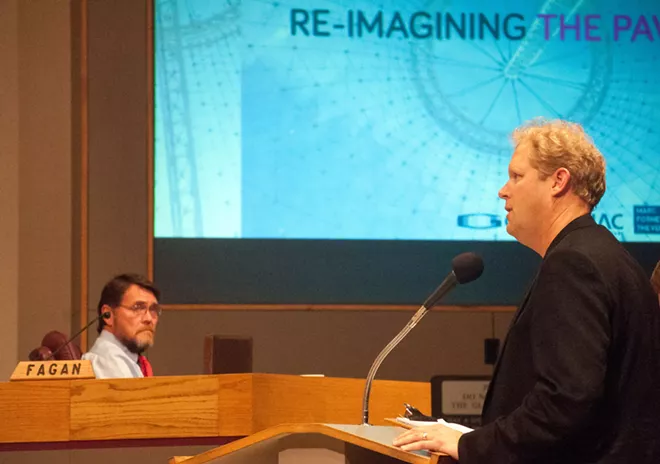
But instead of presenting a range of different possible concepts for what a pavilion covering could look like, the design-build team focused on highlighting all the problems with a pavilion
“Re-covering the pavilion is, we don’t think is much of an opportunity as leaving it covered," Berger Partnership principal Guy Michaelsen told the Park Board on Monday. "The fact that it is uncovered actually makes it unique. If this was covered, arguably it would not be as unique.”
Michaelsen talked about the way that a covered pavilion would create a darker structure inside, block sights of the rest of the park and take away the gorgeous view of the skies. By contrast, he says, the team's preferred approach could create a variety of different possibilities, including
The new design persuaded McGregor.
“I’ve come a long way thinking about this," McGregor says. "And I’ve changed my mind."
He also worried about the serious risk of unexpected costs. What about heavy winds and major snowfall? The condition of the pavilion's structure is unclear. A worst-case scenario, the design-build team warned, could mean replacing the entire structure.
"I don’t think, having been entrusted with the public’s money, it would be responsible
For McGregor, the experience of the Rotary Fountain, which is costing nearly a million dollars to rehab only a dozen after being built, left a bad taste in his mouth. It was a warning for how much a bad investment could cost. "I’m not keen on headlines 10 years from now: ‘The Pavilion Canopy Has Failed! What the Hell Happened’?” McGregor says. He has a souvenir made of the rip-prone original pavilion in his office.
He notes that other designs have already been modified from their original proposals presented to the voters. Voters, for example, approved a new Ice
Some Park Board members, like Susan Traver, scoffed at the design of a covered pavilion:
"I don’t think people want to come to a 'teepee' in the middle of Riverfront Park. I do think people want to see lighting concepts, projection concepts,” Traver says, “A covered teepee is just a shelter that is really large.”
But others, like Steve Salvatori, suggested a compromise. Maybe just cover part of the pavilion. After all, a source of shade is still going to be necessary for the design.
Downtown Spokane Partnership Mark Richard called the new design "intriguing" but warned of the danger of moving so quickly away from a major feature of the original design.
Mike Fagan, the city council representative on the park board, argued that either way, it's crucial that the Parks Department and its contractors do their due diligence to either cover the
“It’s pretty obvious to me that [a covered pavilion] was part of a selling point to get the ballot measure approved by the voters," Fagan says. “I think it’s very, very critical that we definitely listen to the voters here. Because they’re the guys who are funding the project. We’ve got integrity issues that could play out for future ballot issues.”
EDITOR'S NOTE: Publisher Ted S. McGregor Jr. sits on the Spokane Park Board; per Inlander policy, he does not edit columns or news stories involving any park business.
*The original version of this post incorrectly identified the author of the 2015 PowerPoint Presentation.

